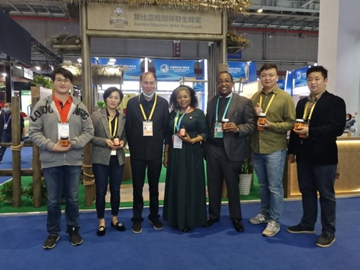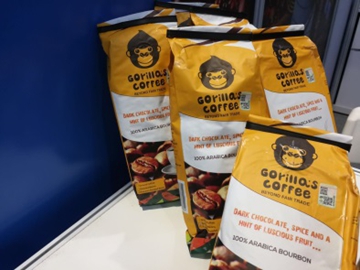African exhibitors display better-quality products at the third CIIE
- By Bridget Mutambirwa
 0 Comment(s)
0 Comment(s) Print
Print E-mail ChinAfrica, November 6, 2020
E-mail ChinAfrica, November 6, 2020

At the ongoing Third China International Import Expo (CIIE), African companies are showing an unyielding spirit despite the prevailing challenges such as lockdowns, travel restrictions and delays in shipping their wares to China that could have otherwise deterred their participation in the expo this year.
I visited some of the African exhibitor stands, such as those from Benin, Djibouti, South Africa, Tanzania, Togo, Tunisia, and Zambia. The participation of these African companies gave me the impression that no matter what the challenges caused by the COVID-19 pandemic African companies are determined and capable of making an indelible mark internationally and have the capacity and resources to supply raw and finished produce under to global consumers.

Improved packaging
In comparison to last year's CIIE which I also attended, the products on display this year were certainly more appealing to the eye. The packaging quality looks even better. As I visited the African stands, I marveled at the new branding on most food products. The branding and food packaging hit with a bang! For example, the packages of chili sauces from Rwanda are in more attractive glass bottles that have golden metal lids and red labels. Red is a very popular color in China. I could tell that the producers of the chili sauces have been researching and improving their packaging to suit international standards and attract more foreign buyers. Also, the packages incorporate both Chinese and English languages on the labels that describe the contents of the products which include chili sauces and chili oil. Again, my guess is that maybe at the previous CIIE, language could have been a possible barrier in attracting more of his potential Chinese buyers.
I almost ignored another stand. What eventually drew my attention toward it was the incorporation of African mascots alongside commonly produced African fruit, nuts and oils on the food packages. For example, instead of only displaying the avocados commonly produced in Kenya, one company incorporates a cartoon of one of the Africa's Big Five (African Elephant, Cape Buffalo, Leopard, Lion and Rhinoceros) on the packaging of baby food. When the exhibitor told me that the product was from Kenya, I was curious to go into the stand and see what else was on display from Africa. I noticed that the dried fruits and nuts sold in this stand were not just packaged in the usual transparent thin plastic packets like the previous year but in colorful shiny opaque packets that would compel any potential buyer to stop by and shop. I also couldn't help but notice the dried food hamper boxes each filled with assorted food products from different African countries. They were packaged exactly in the same way the Chinese food hampers are, a blend of two cultures. So, on one hand I was drawn to the package contents because they were from my home continent and on the other hand, I couldn't resist the packaging style that was familiar to me as it matched that of Chinese brands I'm used to seeing on the shelves in Chinese stores.
Again, I got the impression that the African supplies are indeed studying the market in China and looking for possible features that not only describe Africa on the packages but also appeal to the eye of a foreign buyer at international level.

Support from ambassadors
Despite low exhibitor turn out mostly owing to shipping and travel restrictions caused by the pandemic, for me it was encouraging to see African diplomats rally behind the food suppliers and companies of their countries that could not make it to this year's CIIE. On behalf of their countries they kept the ball rolling. If I was a supplier of the products they displayed, I'd be happy knowing that even in absence personally, they have full support from their ambassadors at this year's CIIE. The ambassadors exhibited a variety of products such as coffee, tea, olive oil, palm oil, Shea butter, dried fruits, soybeans, wines and gem stones.
In another the pavilion I noticed one stand that stood out with African decor and color. The products displayed are from Zambia's Mpundu Wild Honey Limited company. The company was well represented by Chinese staff and Zambian Ambassador to China H.E Ambassador Winnie Chibesakunda. The minute I walked in I felt like greeting everyone in the traditional African fashion because its decor greeted me in the same way. Ambassador Chibesakunda applauded the company's staff back in Zambia for managing to coordinate and supply enough products to exhibit at the exhibition even in absentia. "I'm so proud of the owners of this company. Indeed they are well established and more acquainted with the CIIE. Despite new challenges owing to the pandemic they managed to successfully participate in Shanghai in this year's exhibition but from home (in Zambia)," the ambassador said.

New techniques of marketing
As I explored the pavilions and came across more and more African stands, I wondered how these African producers and suppliers still managed to exhibit their food products. Upon visiting the Food and Agriculture pavilions I noticed that many African food products still found their way to the stalls at the CIIE and are keeping afloat by means of using Chinese online platforms and marketing agents to sell their products on their behalf.
I visited one such Chinese company that is helping to bridge Chinese buyers and African food suppliers. Called Guorui, this Chinese company sells a variety of African produce including avocados, nuts, dried fruits and various snacks all supplied from the continent. It sells on behalf of suppliers via e-commerce platforms such as Taobao, Weibo amongst others.
If one were to ask me what my impression of the third CIIE was with reference to the African exhibits this year, I'd say the turnout was low but Africa certainly put a mark on the map characterized by a relentless spirit to grow and compete internationally despite any challenge. Consecutively hosting the CIIE for three years, China on the other hand has made it easier for African products to gain international recognition by continuing to demonstrate its policy of an open, inclusive, balanced and beneficial-to-all economic development.






Go to Forum >>0 Comment(s)